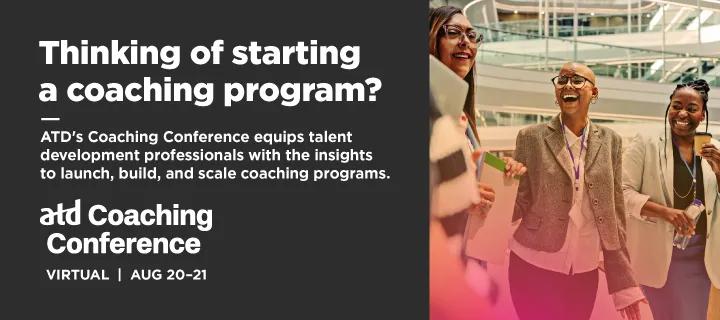ATD Blog
Implement Coaching Within Your Organization in 5 Steps
TD leaders can invest in, implement, and generate support for a coaching program that will ripple through every facet of the organization.
Mon Jun 02 2025

The modern business landscape is ever-changing. Technology is advancing, the expectations of top talent are evolving, and competition across industries is rising. Talent development (TD) leaders in search of professional development methods that can better enable teams to achieve organizational goals are increasingly relying on coaching.
Why? Because coaching has proven to improve communication skills, increase self-confidence, improve work-life balance, increase productivity and well-being, and optimize work performance, among other valuable outcomes, according to the 2022 ICF Global Consumer Awareness Study (GCAS).
Xiaomi, a consumer electronics and smart manufacturing company, decided to implement a coaching program in 2018 to address challenges created by rapid growth. However, once it determined that a coaching program was the right approach to meet the company’s challenges, it still had to tackle the significant question of how to implement a program in a way that would set a strong foundation for the team and support meaningful progress toward the company’s goals.
This is a common challenge! Xiaomi took this on by starting with a coaching framework that correlated its implementation with the company’s needs. This is a wise approach for any organization, and with a few key steps, you can guide your team through the process of creating a framework for your program, too.
Depending on the unique needs of an organization, TD leaders may select among several coaching modalities to achieve desired results:
Managers and leaders using coaching skills, such as active listening, leading with curiosity, or two-way communication, which fosters environments in which teams are more likely to share their ideas and think creatively without fear of judgement
Internal or external professional coach practitioners who can offer one-to-one or team coaching to address specific challenges and support employees in finding practical solutions
A robust coaching culture that blends both coaching modalities to create a ripple effect of the benefits of coaching throughout the organization
Steps to Implement Coaching in Your Organization
A stepwise approach to implementing coaching within a business will result in a seamless and successful process that ends with an integrated coaching culture. Following these five steps will set up your TD team for a triumphant professional development initiative:
Identify existing challenges. Begin by determining where the organization has its most significant challenges—for example, in skills gaps, turnover, engagement, or employee advancement. This may indicate a need to upskill existing employees to fill a skills deficit, attract new talent in areas of growth for the organization, or simply improve the productivity and engagement of the broader workforce.
Secure leadership buy-in. Since coaching is a commitment and an investment, it is critical to get the support of leadership. There are several ways to make a compelling case for coaching. Showcase the impact coaching has had on major organizations to achieve unprecedented success. Engage with an external, professional coach to provide one-to-one executive coaching for leaders so that they may see firsthand what coaching can do.
Adopt the right coaching framework. Once leadership is on board, create a framework or roadmap to guide how coaching will be implemented to support the organization’s defined goals, and how it will be introduced and made available to the team. Determine team members who require coaching, decide on the modality to be offered and at what cadence, and settle on other logistical considerations that will affect the formation of a coaching program.
Prioritize standards and best practices. Coaching remains a largely unregulated industry. But just as you would prioritize certification and education before seeing a doctor, therapist, dentist, or real estate agent, do the same when selecting a coach. To ensure a coaching experience aligned with science-backed industry best practices, select coaches with credentials or coach training programs that are accredited by industry standard-bearers. ICF offers a coach finder that provides access to thousands of credentialed coaches across countries, specialties, experience levels, and more.
Measure the impacts. Once coaching is fully implemented, measure the outcomes compared to where the organization started pre-coaching. For Xiaomi, this included a 33 percent improvement in the leadership index, a tool which measures the effectiveness of leadership, for managers using coaching; a 21 percent increase in employee engagement; and a 1.4x increase in revenue over a six-year period.
From Coaching Support to Coaching Culture
When coaching is implemented in a layered fashion, beginning with access to internal or external coach practitioners or through coach training for leaders and managers to develop a coach approach to their leadership, it can create a trickle-down effect throughout all levels of the organization. This sort of grassroots introduction to coaching drives the best demonstration of its value, because it grows in popularity as individuals engage with it and speak highly of their experience or show its value through improvements. As an organization expands upon its coaching program and more employees gain access to coaching, the organization will develop a comprehensive coaching culture. A true coaching culture incorporates six key elements, according to the 2023 ICF and HCI Defining New Coaching Cultures study:
Employees who value coaching
Senior executives who value coaching
Managers and leaders or internal coaches receiving accredited coach training
Availability of all three coaching modalities
A dedicated line item in the budget for coaching
Equal access to coaching for all employees
The benefits of a coaching culture can solve many of the challenges that first prompt TD leaders to implement coaching. These benefits include strengthened leadership development, boosted employee engagement, better employee relations, improved team functioning, and more. Remember that the organizations that get the most out of a coaching culture make coaching available to employees at all levels.
Be a Catalyst for Accelerated Growth
As a TD expert, you are well-positioned to bring your organization into the future when it comes to professional development opportunities. Coaching has demonstrated time and time again that it not only enhances what high-performing teams can achieve but cultivates work environments that bring out the best of each employee by considering their individualized strengths and areas for growth. Xiaomi, for instance, attributes its success in developing an electric car and fully automated car factory to its commitment to coaching.
By embracing a stepwise approach, TD leaders can invest in, implement, and generate support for a coaching program that will ripple through every facet of the organization and ultimately achieve a surplus of benefits.
Want to learn more about coaching? Attend the virtual ATD Coaching Conference as experts like ICF's Robert Garcia share how to elevate your skills and programs with the power of coaching.
Missed the event? Consider ATD's Coaching Certificate.

